-
01-01-2015
Adverse events and safety in nursing care
Revista Brasileira de Enfermagem. 2015;68(1):144-154
Abstract
Adverse events and safety in nursing care
Revista Brasileira de Enfermagem. 2015;68(1):144-154
DOI 10.1590/0034-7167.2015680120i
Views0See moreObjective:
to identify the scientific publications about adverse events in nursing care in adult hospitalized patients and discuss the main adverse events in nursing care.
Method:
Integrative revision with a qualitative approach. The data were collected at LILACS, MEDLINE, BDENF and the library SCIELO and were submitted to thematic analysis.
Results:
three categories were developed: Adverse events in nursing care; The main causes of the adverse events in nursing care; Attitude of nursing professionals in face of errors. The main events were identified in nursing care with emphasis on the medication error, the failure to perform dressings and falls of patients. The importance of instruments was emphasized for notification of adverse events in the institutions. However the fear of punishment on professionals stimulates the underreporting of events.
Conclusion:
it is important to discuss effective prevention strategies that ensure patient safety in healthcare institutions.
-
01-01-2015
Staphylococcus aureus meticilino resistente adquirido na comunidade: um problema mundial
Revista Brasileira de Enfermagem. 2015;68(1):136-143
Abstract
Staphylococcus aureus meticilino resistente adquirido na comunidade: um problema mundial
Revista Brasileira de Enfermagem. 2015;68(1):136-143
DOI 10.1590/0034-7167.2015680119p
Views0Objetivo:
descrever a epidemiologia dos casos de CA-MRSA no Brasil de forma a compreender sua ocorrência, fatores de risco associados e formas de manejo em relação à situação mundial.
Método:
revisão integrativa e para seleção dos estudos utilizou-se as bases de dados: Scopus, Science direct, Isi Web of Knowledge, PUBMED e BVS.
Resultados:
foram identificados dez artigos nacionais que descreveram 21 casos de CA-MRSA principalmente em crianças, adolescentes e adultos com quadro de infecção de pele e tecidos moles evoluindo para infecções graves relacionados ao clone Oceania Southwest Pacific Clone (OSPC) que resultaram em hospitalização.
Conclusão:
apesar do CA-MRSA ser considerado um micro-organismo de relevância mundial verificou-se a escassez de dados publicados sobre sua epidemiologia no Brasil, o que dificultam o delineamento da realidade do país frente ao CA-MRSA.
Keywords:Controle de InfecçõesFarmacorresistência BacterianaInfecções Comunitárias AdquiridasStaphylococcus Aureus Resistente à MeticilinaSee more -
01-01-2015
Prevention and non-pharmacological management of pain in newborns
Revista Brasileira de Enfermagem. 2015;68(1):131-135
Abstract
Prevention and non-pharmacological management of pain in newborns
Revista Brasileira de Enfermagem. 2015;68(1):131-135
DOI 10.1590/0034-7167.2015680118i
Views0See moreObjective:
to describe the main non-pharmacological interventions for pain relief in newborns available in Neonatal Intensive Care Unit.
Method:
an exploratory search of the MedLine, Lilacs and Scielo online databases was conducted to retrieve references of studies published from 2004 to 2013.
Results:
several non-pharmacological interventions were shown to be effective, to represent low risk for neonates and to have a low operational cost. The ones most often discussed in the literature were: oral administration of glucose/sucrose, non-nutritive sucking, breastfeeding, skin-to-skin contact, facilitated tucking and swaddling.
Conclusion:
healthcare teams should be familiar with these methods and use them more effectively in Neonatal Intensive Care Unit daily routines, so as to ensure that newborns receive qualified and more human care.
-
01-01-2015
BANFISA e (IN)DICA-SUS na graduação em saúde: o lúdico e a construção de aprendizados
Revista Brasileira de Enfermagem. 2015;68(1):124-130
Abstract
BANFISA e (IN)DICA-SUS na graduação em saúde: o lúdico e a construção de aprendizados
Revista Brasileira de Enfermagem. 2015;68(1):124-130
DOI 10.1590/0034-7167.2015680117i
Views0See moreObjectives:
to analyze the learning built during the matches of the games by students of the subject Gestão de Políticas Públicas em Saúde at the Universidade de Brasília.
Method:
exploratory, descriptive research, in a qualitative approach, with 26 students from various graduation courses in health, using a questionnaire and participant observation.
Results:
participants reinvented rules, related issues addressed in the games to the reality, interacted with colleagues and had fun throughout the match. Comparing the games in relation to ludicity, the BANFISA was more attractive than the (IN) DICA-SUS, although they are complementary.
Conclusions:
learning constructed by the students goes beyond the content of the subject; involve the active participation in group and creativity.
-
01-01-2015
Chinese auriculotherapy to improve quality of life of nursing team
Revista Brasileira de Enfermagem. 2015;68(1):117-123
Abstract
Chinese auriculotherapy to improve quality of life of nursing team
Revista Brasileira de Enfermagem. 2015;68(1):117-123
DOI 10.1590/0034-7167.2015680116p
Views0See moreObjective:
to evaluated the effi cacy of auriculotherapy for improving quality of life and reducing stress in nursing staff.
Method:
single-blind radomizad clinical trail envolving 175 subjects randomized in: Control (G1), Protocol Group (G2) and without Protocol Group (G3). They were evaluated by the Stress Symptoms List and SF36v2 at baseline, after 12 sessions and follow up (30 days), between January and July 2012.
Results:
both intervention groups reduced stress (p <0.05) with greater effect for G3 (d = 1.15). G3 was also higher for improving life quality especially the physical domain (p = 0.05).
Conclusion:
individualized auriculotherapy (G3) had greater effect compared to the protocol auriculotherapy (G2) for reducing stress and improving life quality.
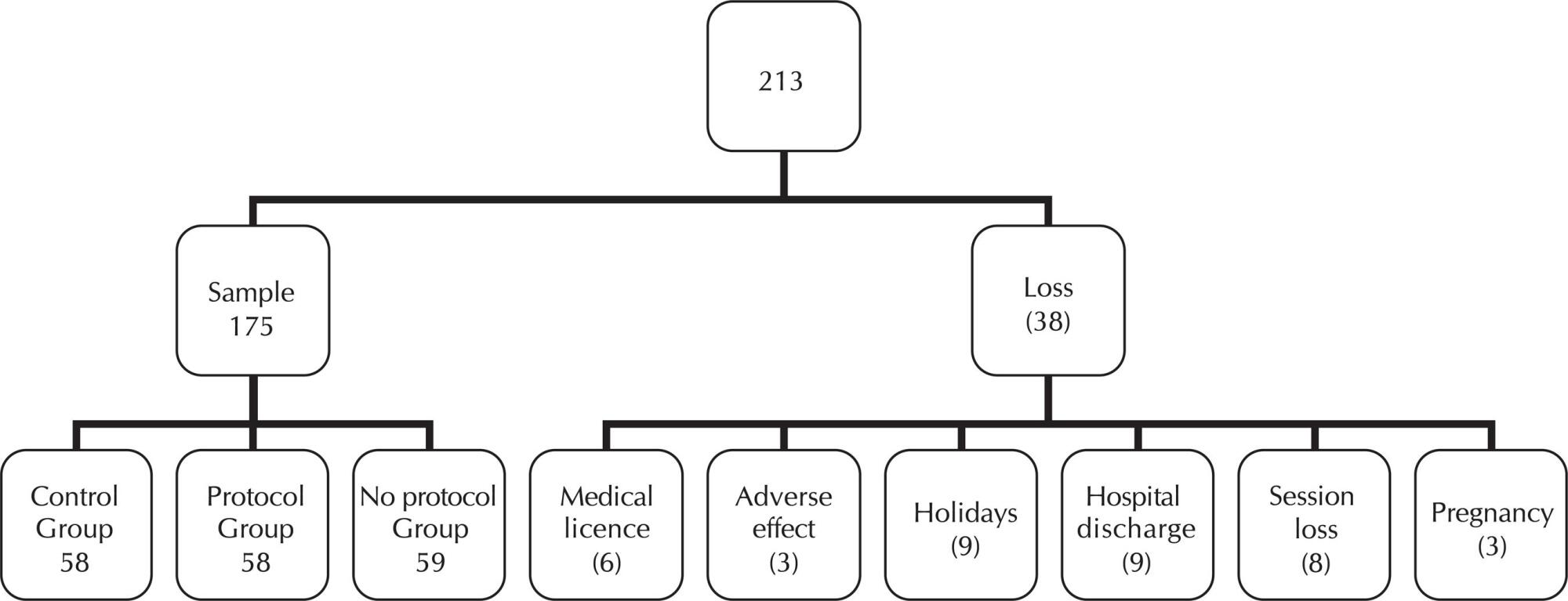
-
01-01-2015
Adherence to foot self-care in diabetes mellitus patients
Revista Brasileira de Enfermagem. 2015;68(1):111-116
Abstract
Adherence to foot self-care in diabetes mellitus patients
Revista Brasileira de Enfermagem. 2015;68(1):111-116
DOI 10.1590/0034-7167.2015680115p
Views1See moreObjective:
to analyze the self-care of patients with type 2 diabetes mellitus in the Family Health Strategy in Teresina-PI.
Method:
search cross selected by simple random sampling, 331 people with diabetes mellitus. Data collection took place from August to December 2012 with the use of Self-Care Activities Questionnaire with Diabetes and structured instrument for recording information socioeconomic and guidance received by the professional nurse.
Results:
the data revealed that patients have poor adherence to blood glucose monitoring, the physical exercise and foot care, but with good adherence to the medication. Only 38.7% of the sample examined the feet of fi ve to seven days a week. Statistically signifi cant association between self-care activities with their feet and orientations of nurses (p < 0,05).
Conclusion:
that there is need to raise awareness with regard to the development of skills for self-care.
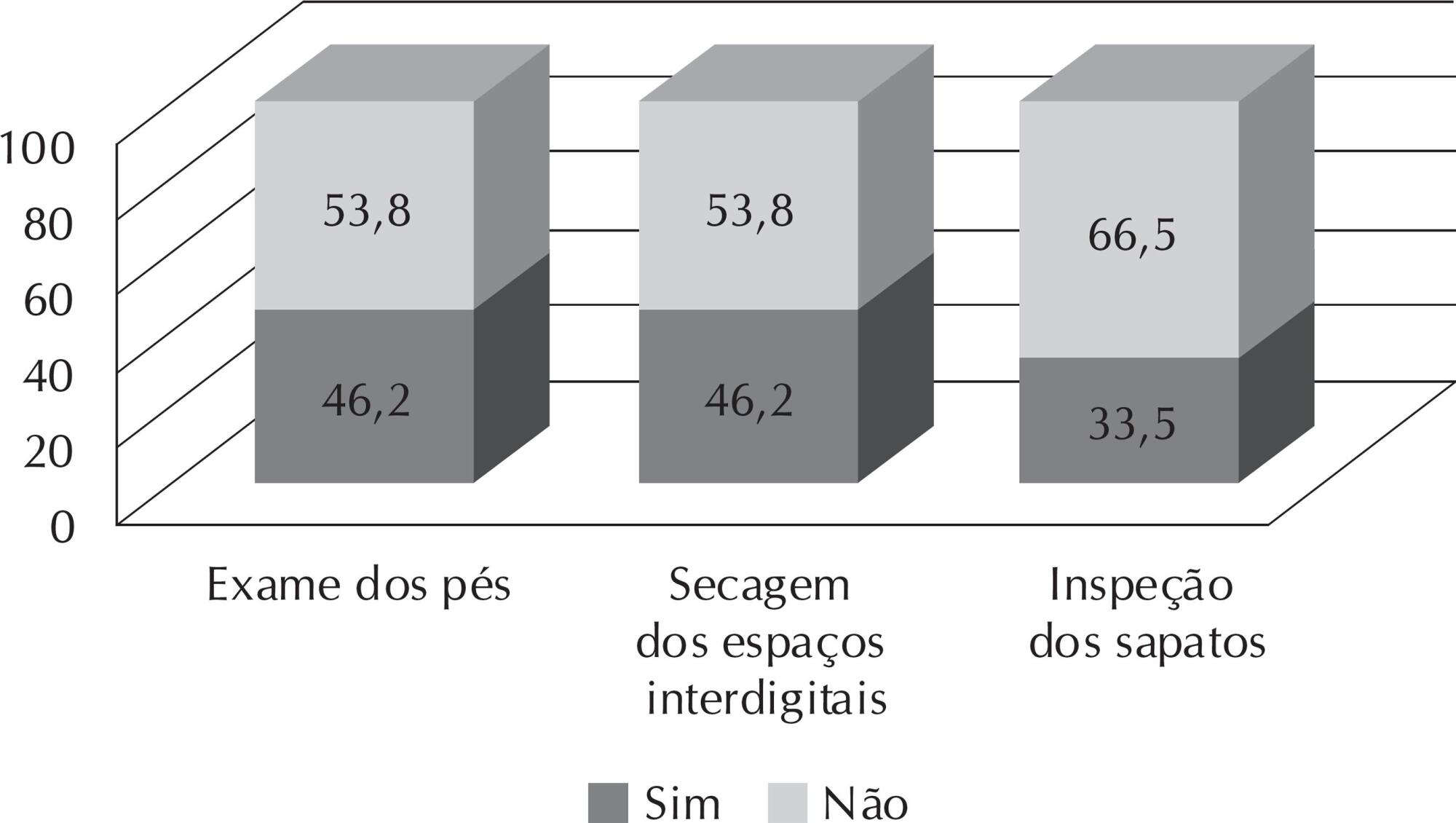
-
01-01-2015
Patients with disorders of consciousness: vital, facial and muscular responses to music or messages
Revista Brasileira de Enfermagem. 2015;68(1):102-110
Abstract
Patients with disorders of consciousness: vital, facial and muscular responses to music or messages
Revista Brasileira de Enfermagem. 2015;68(1):102-110
DOI 10.1590/0034-7167.2015680114p
Views1See morePurposes:
to compare vital signs, facial expression and basal electroneurographic signs with measures during stimuli music, message or “silence” in coma patients, vegetative status or sedated; and relating the score of Glasgow Results Scale with the intervention realized.
Method:
a Monoblind Transversal Controlled Clinical Trial to researcher. The distribution, among the three groups, was randomized (experiment with music, experiment with message or control). Two assessments (sessions) were performed with interval of 40 minutes on the same day.
Results:
most of the 76 patients were male, between 18 to 36 years old and hospitalized due to trauma. Statistically signifi cant changes were found in the variables referred to temperature, facial expression, electroneurography and Glasgow Results Scale; more frequent alterations in second session, in coma and vegetative patients, in frontal muscles and in experiment group.
Conclusions:
the facial expression and the electroneurography seem to be more trustworthy variables than vital signs to evaluate consciousness.
-
01-01-2015
Prevalence of minor psychiatric disorders in socio-educational agents in the state of Rio Grande do Sul
Revista Brasileira de Enfermagem. 2015;68(1):93-101
Abstract
Prevalence of minor psychiatric disorders in socio-educational agents in the state of Rio Grande do Sul
Revista Brasileira de Enfermagem. 2015;68(1):93-101
DOI 10.1590/0034-7167.2015680113p
Views0See moreObjective:
to determine the prevalence and factors associated with minor psychiatric disorders (MPD) in socio-educational agents.
Method:
it is a cross-sectional study with 381 socio-educational agents the Centers for Socio-Educational Services in the State of Rio Grande do Sul, Brazil. The Brazilian versions of the Scale of Demand-control-social support at work and the Self Reporting Questionnaire-20 have been applied.
Results:
the results showed a prevalence of suspicion MPD of 50.1%. They showed to be related to suspicion of MPD : being female (55.7%), having age up to 44 years old (58.5%), no physical activity (57.4%), do not have time for leisure (75%), make use of medication (61.4%), require medical attention (56.9%) and psychological counseling (72.7%), not being satisfied with the workplace (61.7%) and need for time off from work (65.6%).
Conclusion:
the study provides important data about the mental health of agents, showing the need for the involvement of managers and of the health service of worker’s health in planning actions to promote health of these workers.
-
ORIGINAL ARTICLE05-21-2021
Prevalence and factors associated with acute kidney injury in patients in intensive care units
Revista Brasileira de Enfermagem. 2021;74(2):e20200790
Abstract
ORIGINAL ARTICLEPrevalence and factors associated with acute kidney injury in patients in intensive care units
Revista Brasileira de Enfermagem. 2021;74(2):e20200790
DOI 10.1590/0034-7167-2020-0790
Views0See moreABSTRACT
Objectives:
to identify the prevalence and factors associated with the development of acute kidney injury in critically ill patients.
Methods:
a cross-sectional study, conducted from June 2018 to August 2019. The Kidney Disease Improving Global Outcomes was used to classify acute kidney injury. A significant value was set at p<0.05.
Results:
a total of 212 patients were included, of whom 35.8% evolved into an acute kidney injury. Patients with acute kidney injury had hypertension, higher levels on severity scores and a higher baseline creatinine rate> 1.5 mg/dL, also, when applied logistic regression, were 7 times more likely to develop acute kidney injury, Odds Ratio 7.018. More than half (56.6%) of the patients with acute kidney injury died. Moreover, 26.7% of these patients developed pressure sore.
Conclusions:
the prevalence of kidney injury was high (35.8%). The patients who developed it had a higher severity, mortality, and pressure sore index.
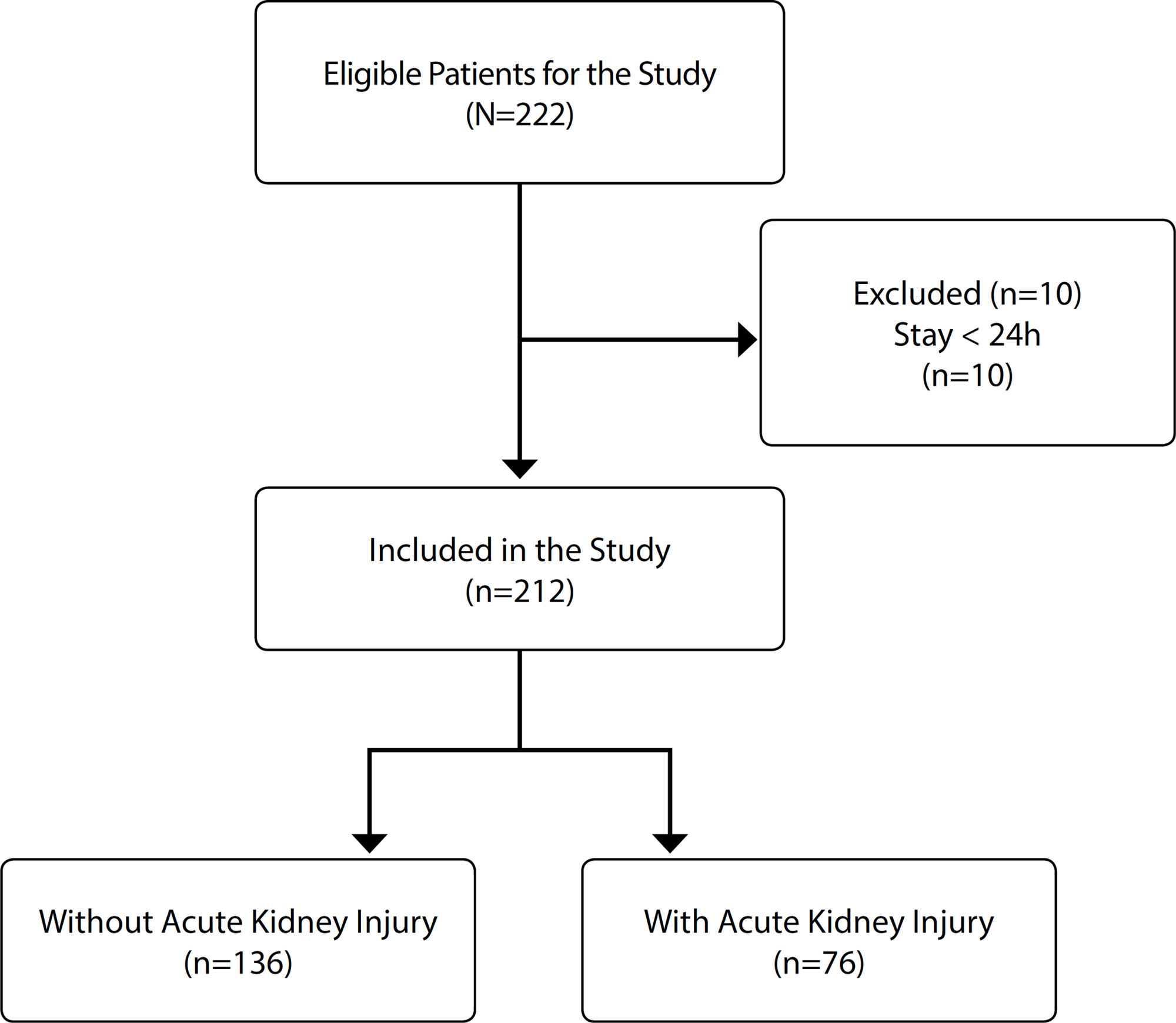
-
ORIGINAL ARTICLE08-08-2022
Social and territorial inequalities in the mortality of children and adolescents due to COVID-19 in Brazil
Revista Brasileira de Enfermagem. 2022;75(6):e20210482
Abstract
ORIGINAL ARTICLESocial and territorial inequalities in the mortality of children and adolescents due to COVID-19 in Brazil
Revista Brasileira de Enfermagem. 2022;75(6):e20210482
DOI 10.1590/0034-7167-2021-0482
Views0See moreABSTRACT
Objective:
To analyze the mortality rate of COVID-19 among children and adolescents aged 0 to 14 years.
Methods:
Ecological and exploratory study of children’s mortality rate by COVID-19 in Brazil, from February to October 2020. The study used the Severe Acute Respiratory Syndrome database to collect the data and made the analysis using descriptive spatial statistics by age and race/color classification.
Result:
The mortality rate due to COVID-19 represented 1.34 deaths per one hundred thousand in the total group evaluated. The age group with the highest frequency and mortality rate was 1 to 4 years of age. There is a higher frequency of deaths in the brown and Indigenous population.
Conclusion:
The distribution of deaths due to COVID-19 is unequal in the national territory, and there is a wide variation in the mortality rate by age and race/color groups.
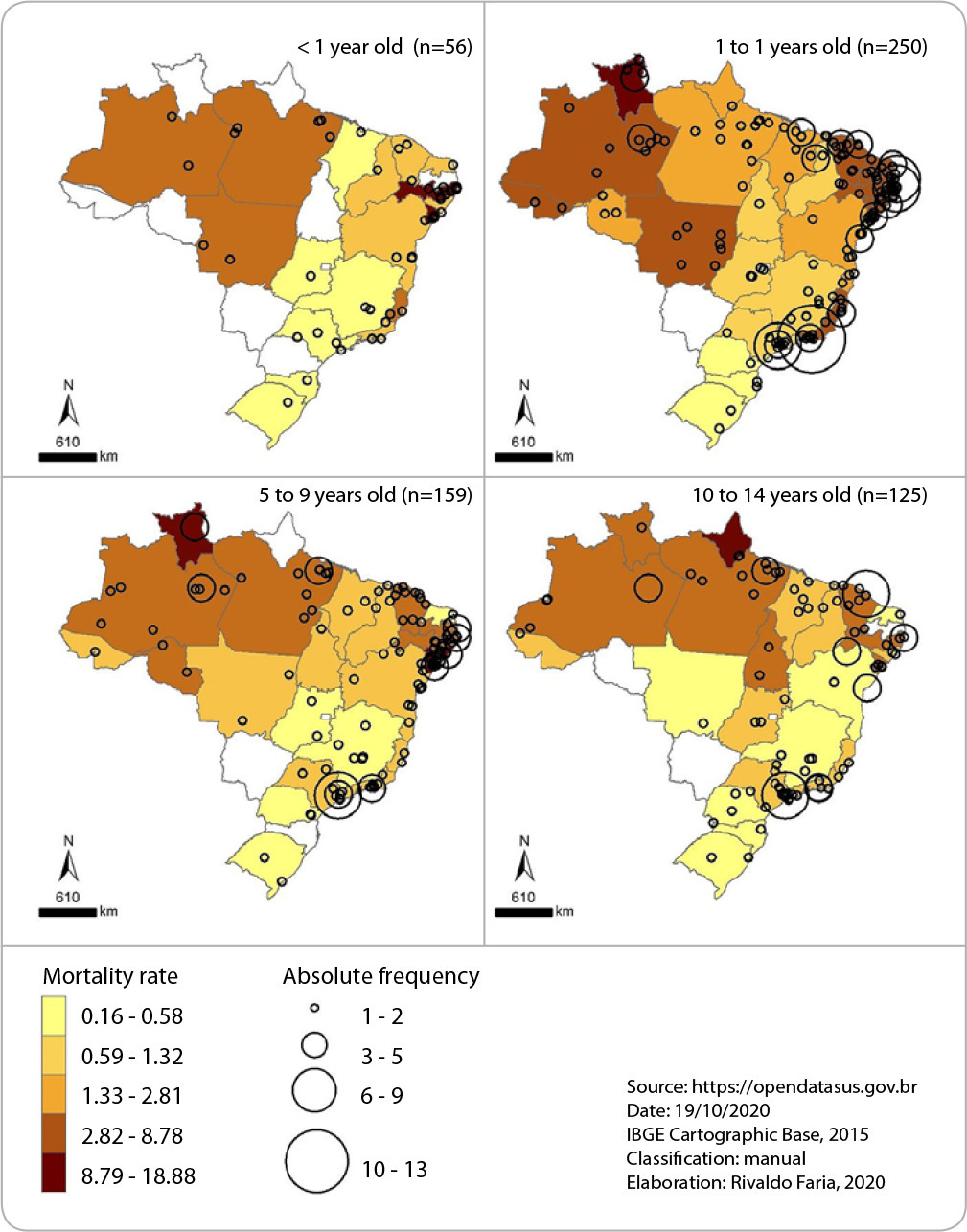
-
ORIGINAL ARTICLE06-09-2021
Professional practice in caring for maternal grief in the face of stillbirth in two countries
Revista Brasileira de Enfermagem. 2021;74(3):e20200253
Abstract
ORIGINAL ARTICLEProfessional practice in caring for maternal grief in the face of stillbirth in two countries
Revista Brasileira de Enfermagem. 2021;74(3):e20200253
DOI 10.1590/0034-7167-2020-0253
Views0See moreABSTRACT
Objective:
to understand professional care for maternal grief in the puerperium of stillbirth.
Methods:
a clinical-qualitative study with all the women who had stillbirths living in Maringá (Brazil) and participating in the Center d’Études et de Recherche in Family Intervention at the University of Quebec in Outaouais in Gatineau (Canada). Semi-structured interviews were carried out and the relevant aspects were categorized into themes.
Results:
the identified categories were: Assistance received in the puerperium with a focus on grief: hospital and outpatient environment, and Professional support in coping with maternal grief after fetal loss: with contact and memories, without contact and without memories and impossibilities of contact with the baby.
Final
considerations: the need for a multidisciplinary support and monitoring network for women who experienced fetal loss was evident. From this study, a routine of care for grief can be implemented in Brazil based on experiences in Canada.
-
ORIGINAL ARTICLE06-18-2021
Standard drug consumption: a study with elderly people in Primary Health Care
Revista Brasileira de Enfermagem. 2021;74(3):e20200729
Abstract
ORIGINAL ARTICLEStandard drug consumption: a study with elderly people in Primary Health Care
Revista Brasileira de Enfermagem. 2021;74(3):e20200729
DOI 10.1590/0034-7167-2020-0729
Views0See moreABSTRACT
Objective:
To identify the pattern of medication consumption among the elderly assisted in Primary Health Care.
Methods:
Descriptive, quantitative, cross-sectional study, with a sample of 315 elderly people, in a city in rural Rio Grande do Norte.
Results:
The average age was 72.41 years, with an average consumption of 3.15 medications per day, ranging from 1 to 16 medications daily. There was a prevalence of antihypertensives, antidiabetics, hypolipidemic and psychotropic drugs. 238 different drugs were mentioned, 15 of which were “potentially inappropriate drugs” for the elderly. Most of these patients follow treatment according to medical prescription, with low self-medication. Most elderly people buy their drugs, although many are available for free.
Conclusion:
The most consumed drugs are consistent with the most reported diseases (hypertension and diabetes). The daily use of inappropriate medications for the elderly is worrying, especially psychotropics, given the risks of dependence or health complications of these users.
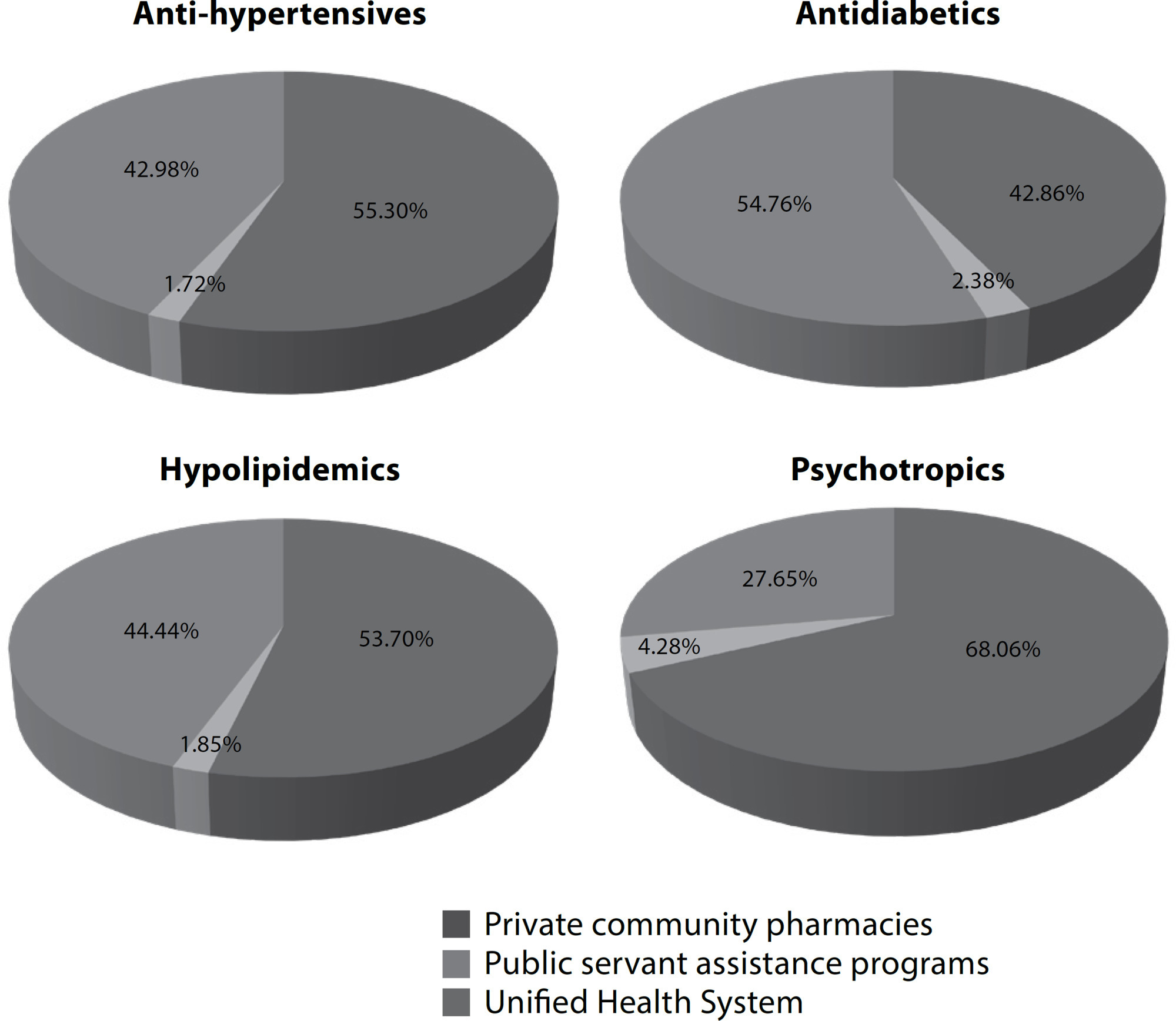
-
REVIEW11-26-2022
Parental burnout: a scoping review
Revista Brasileira de Enfermagem. 2022;75:e20210203
Abstract
REVIEWParental burnout: a scoping review
Revista Brasileira de Enfermagem. 2022;75:e20210203
DOI 10.1590/0034-7167-2021-0203
Views0See moreABSTRACT
Objective:
to map available evidence on parental burnout theme.
Method:
scoping review as according to the Joanna Briggs Institute. Search in January 2021, in six databases of publications in English, Portuguese or Spanish, without time limits. Data extracted and descriptively analyzed by three independent researchers.
Results:
374 articles were identified and 20 were included in the final sample, all published in English, from 2017 onwards. Parental burnout is a complex, multifactorial problem, distinct from burnout cases, depressive symptoms and other mental health alterations. It affects 0.2 to 20% of parents, has validated and suitable instruments for measurement; if not treated, can have consequences on marital life, work relationships, child neglect and violence.
Conclusions:
this is a recent theme that needs to be explored, due to the possible impact on children’s and families’ health and on parents’ work processes. Protocol registered in the Open Science Framework ().
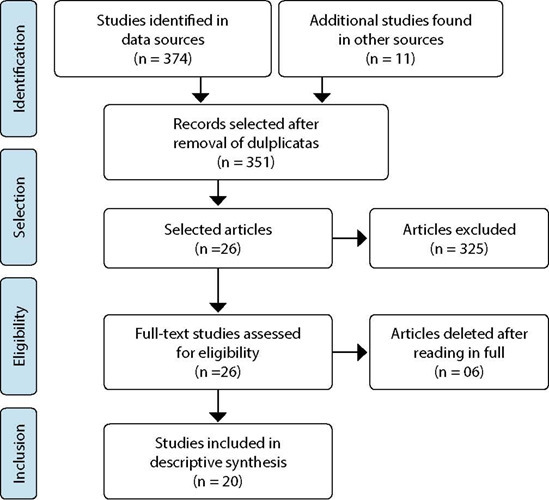
-
EXPERIENCE REPORT06-09-2021
Genograma e ecomapa como estratégias lúdicas de ensino de enfermagem na Atenção Primária à Saúde
Revista Brasileira de Enfermagem. 2021;74(3):e20201106
Abstract
EXPERIENCE REPORTGenograma e ecomapa como estratégias lúdicas de ensino de enfermagem na Atenção Primária à Saúde
Revista Brasileira de Enfermagem. 2021;74(3):e20201106
DOI 10.1590/0034-7167-2020-1106
Views0See moreABSTRACT
Objectives:
to report the experience using ludic strategies for the teaching-learning in the elaboration of the genogram and ecomap; and the use of these instruments by Nursing students in the Primary Health Care services.
Methods:
an experience report of the discipline Integrity of Care I (Integralidade do Cuidado I), of the Nursing School of Ribeirao Preto. Problems scenarios were created to approach the genogram and ecomap, comprising different family arrangements, represented by pedagogic puppets.
Results:
students actively participated, held collective discussions, elaborated genogram, and ecomap, identified the type of family, and the stages of the vital cycle, providing increased dynamics and interactivity. Subsequently, in supervised activities in Primary Health Care services, students elaborated the genogram and ecomap to monitor a family.
Final Considerations:
the use of ludic strategies propitiates the teamwork, active interaction of the group, and the creativity. The articulation between theory and practice resulted in a significant learning.
-
ORIGINAL ARTICLE07-14-2021
Venous ulcer healing treated with conventional therapy and adjuvant laser: is there a difference?
Revista Brasileira de Enfermagem. 2021;74(3):e20201117
Abstract
ORIGINAL ARTICLEVenous ulcer healing treated with conventional therapy and adjuvant laser: is there a difference?
Revista Brasileira de Enfermagem. 2021;74(3):e20201117
DOI 10.1590/0034-7167-2020-1117
Views0See moreABSTRACT
Objectives:
to evaluate the effects of venous ulcer healing in patients after six months of conventional treatment and adjuvant low-power laser therapy.
Methods:
prospective cohort study nested in a randomized clinical trial with 38 patients, allocated into an intervention group (conventional treatment and adjuvant laser therapy) and a control group (conventional treatment). Patients were followed up as outpatients, sociodemographic and clinical variables were collected, and indicators of the outcomes Wound healing: secondary intention (1103) and Tissue integrity: skin and mucous membranes(1101) of the Nursing Outcomes Classification. Generalized estimating equations, Kaplan-Meier tests, and robust Poisson regression were used in the analysis.
Results:
the clinical indicators Decreased wound size and Scar formation showed a statistically significant difference in the intervention group, higher number of healed wounds, lower rate, longer time to relapse.
Conclusions:
laser therapy adjuvant to conventional treatment returned better results in healing and lower recurrence rates after six months of intervention.
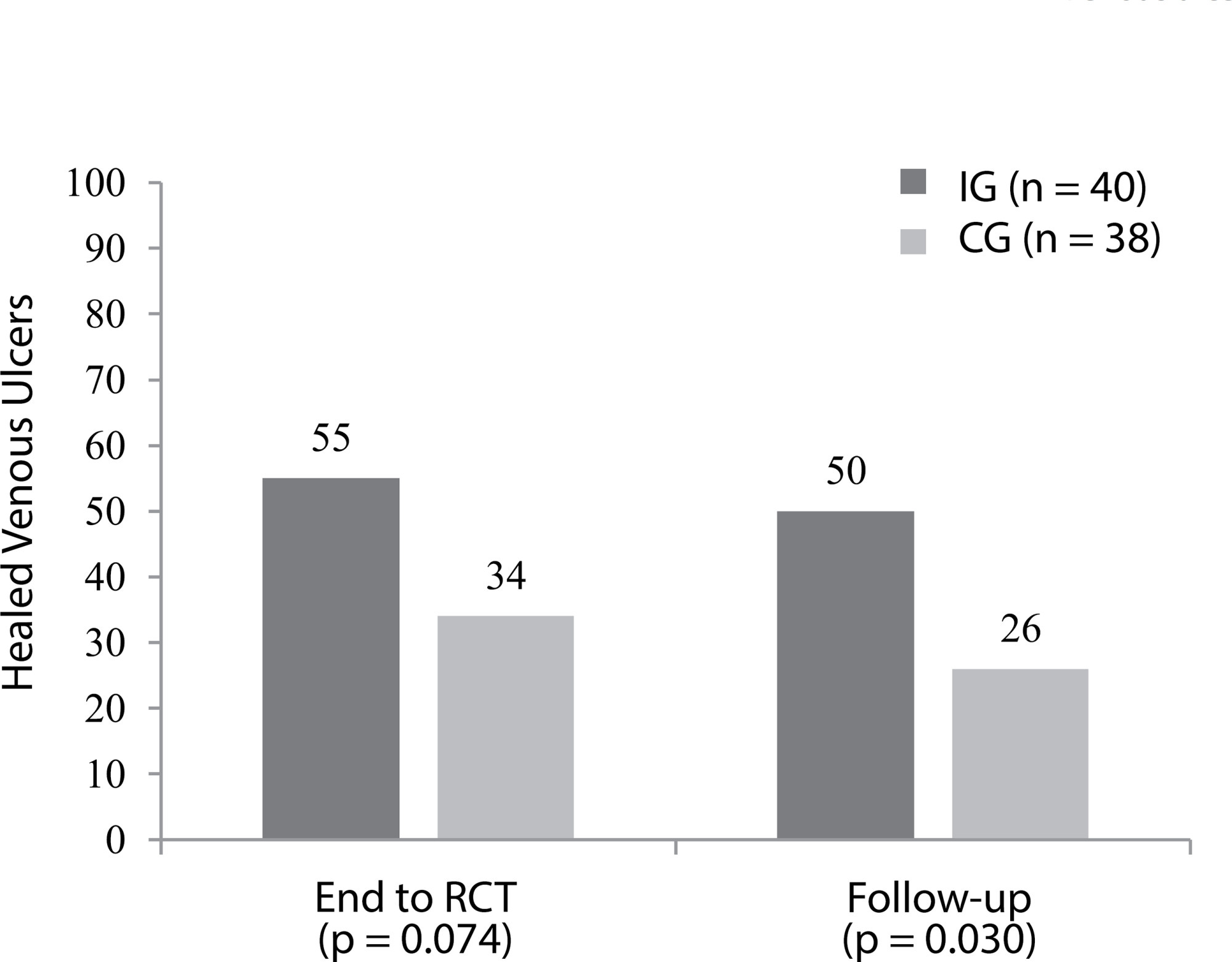
-
REVIEW11-19-2022
Nursing care for bed bath in patients with COVID-19: an integrative review
Revista Brasileira de Enfermagem. 2022;75:e20200704
Abstract
REVIEWNursing care for bed bath in patients with COVID-19: an integrative review
Revista Brasileira de Enfermagem. 2022;75:e20200704
DOI 10.1590/0034-7167-2020-0704
Views0See moreABSTRACT
Objective:
to identify the main nursing care procedures for performing bed bath in patients with COVID-19.
Method:
an integrative literature review. Five stages were followed for this research: research question elaboration (identification of the problem), search of studies in literature, study assessment, data analysis, and presentation of review. To search for primary studies, the VHL and SciELO databases were selected.
Results:
initially, 55 publications were found. After reading and analyzing the abstracts, the sample consisted of 15 studies.
Conclusion:
patients with the new coronavirus have specific care to perform a bed bath, oral, intimate and skin hygiene. It is important that professionals use adequate personal protective equipment, perform humanized care, continuously observing patients’ vital signs to avoid occurrence of adverse events, promoting patient safety.
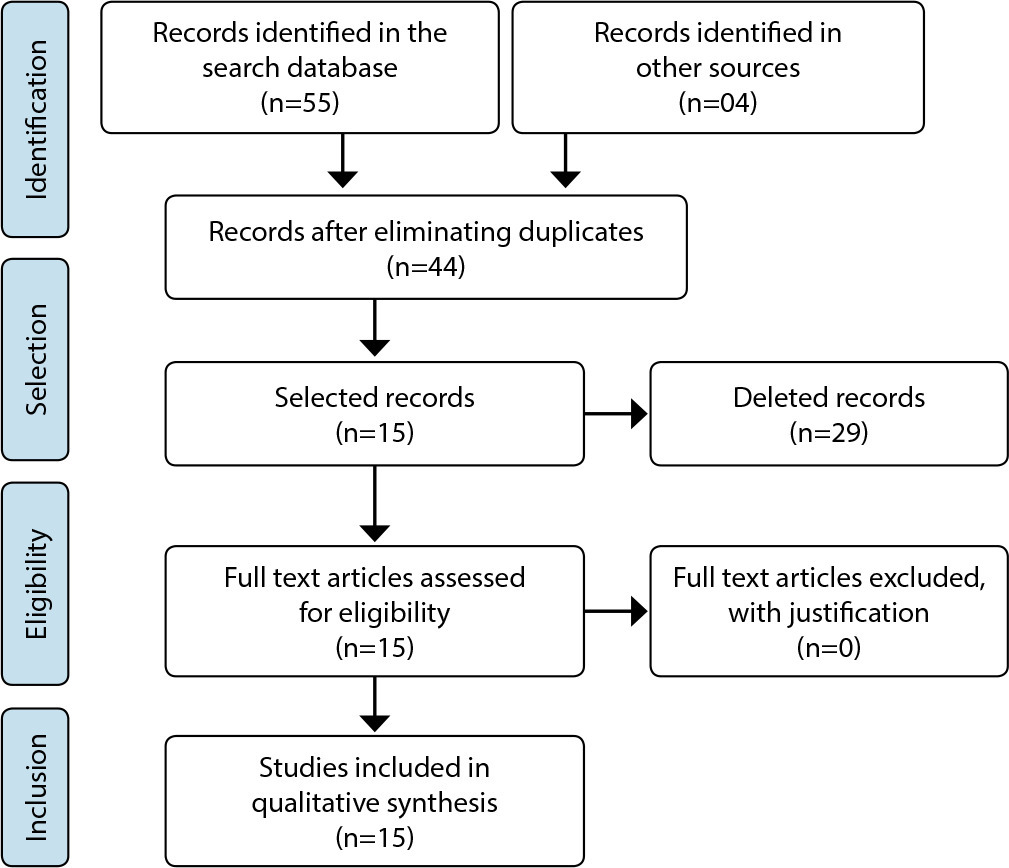
Search
Search in:
Nuvem de Tags
Adolescente (85) Atenção Primária à Saúde (239) COVID-19 (91) Criança (91) Cuidados de Enfermagem (269) Educação em Enfermagem (151) Educação em Saúde (139) Enfermagem (930) Enfermagem Pediátrica (86) Estudantes de Enfermagem (77) Estudos de Validação (131) Família (87) Idoso (208) Promoção da Saúde (99) Qualidade de Vida (104) Saúde do Trabalhador (86) Saúde Mental (145) Saúde Pública (82) Segurança do Paciente (150) Tecnologia Educacional (100)



